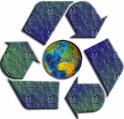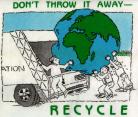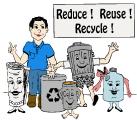This Land is Your Land, This Land is My Land...
A Lesson in Environmental Science Using a Four-Step Learning Cycle

Activity #1: Exploration/ Discovery
My students need to be aware of global issues, such as environmental concerns, in order to sense the urgency of change in our society. I want my students to remove the shade that blinds their eye to the destruction that continues to happen to our Mother Earth. I want to rid them of the “who cares” attitude and make them active participants and accountable citizens onto the Earth that gave us what we now take for granted: clean air, crystal-clear streams, rivers and oceans, and fertile soil. Through this experience, I hope to nurture their curiosity in ecology, but also in law and politics (as we all know, any true endeavor will require some knowledge of applicable laws and the people who manage these laws). But most importantly, I want to plant the seed of individual responsibility of protecting and conserving our Mother Earth.
The specific concept developed will be in accordance with the Texas Essentials Knowledge and Skills:
TEKS 112.24 Science, Grade 8
8.14 Science concepts. The student knows that natural events and human activities can alter Earth systems. The student is expected to:
(C) describe how human activities have modified soil, water, and air quality.
Four stations will be set up. Station #1 will have pictures of contaminated soil. Station #2 will have pictures of contaminated air. Station #3 will have pictures of contaminated water. Station #4 will have pictures of wildlife that has been affected by pollution. Each student will visit the stations and record in their journal what they see, how they feel about the picture and what they would change if given the chance.
After the visit at each station, the students would be placed in groups of no more than four. These groups will be referred to as “Group A”, “Group B”, “Group C”, etc. They are to discuss their journal entries in their group.
There are no safety precautions that need to be followed in this activity.
Activity #2: Development/ Support
Building on their experience from Activity #1 and in order to have students realize that pollution and environmental concerns are El Paso’s problem too, they will visit the Rio Grande banks, close to the UTEP campus, ASARCO, and further west. The students will use a Global Positioning System (GPS) instrument to record their exact coordinates. They are to stay in the same groups as in Activity #1, recording observations using WORKSHEET #1 and taking pictures with a digital camera (to be borrowed from the Journalism Department; one camera for each group). Safety precautions for this activity include using caution while walking the river bank to avoid slipping and falling, using gloves (thick “dishwashing-latex” gloves) to handle any specimens found at the river, and using hand sanitizer upon completion of this field trip.
Upon returning to class, each group will share their findings with the class. In their own groups, students will address environmental questions found in WORKSHEET #2 and will record their responses in their journal.
Through their experiences in Activities #1 & #2, students will formulate definitions to the terminology listed below. These definitions will take the forms of flashcards. The flash cards are to have a drawing or picture (ok to use digital pictures from their visit to the Rio Grande) on one side depicting a visual image of the term, and on the back of the flashcard a definition (see the attached flashcard).
Terminology:point source pollution, nonpoint source pollution, pesticide, fertilizer, sewage, conservation, composting, recycling, biodegradable, stream discharge, sanitary landfill, hazardous waste, pollutant
Students may visit relevant sites, such as the ones listed below, to further enhance the definition of the terminology and to further clarify the concept of human impact on soil, water, and air quality. Visiting these web-site will also give students an outlook on local, state, federal, international, and political efforts to address these and other environmental concerns.
To read more about recycling tires.
To read more about mosquitoes, disease and scrap tires.
To read more about globalization and changes in patterns of disease infection due to mosquitoes that breed in abandoned tires.
To read more about polluters paying fines.
To read more about water dispute in the Rio Grande.
To read more about air quality, hazardous waste, recycling, solid waste, and water resources in the US-Mexico border.
To read more about the Great American Clean Up and recycling services, in El Paso, Texas and working together for a cleaner, healthier more beautiful community environment.
To read more about recycling crude oil.
Activity #3: Expansion/ Application
During a 3-day observation period, students will scrutinize their home environment recording disregard for the environment and ideas to become more responsible inhabitants of our Mother Earth.Students must have at least five entries and will log their observations using WORKSHEET#3. Students may re-visit the websites found in activity #2 to find possible solutions and to successfully complete the “How can this change” column of WORKSHEET #3.
ALTERNATE ACTIVITY
Students can opt to participate in a more comprehensive endeavor targeting their community rather than their home. WORKSHEET #3 must still be used and there must be at least five entries.
An example for a community undertaking is to perhaps visit a park and observe how people interact. Students may closely observe if trash receptacles are being used (are the park users leaving the park as they found it or better), and documenting under the “How this can change” column ways of enforcing cleaner parks; i.e.: utilizing different trash receptacles for “trash” and “aluminum cans”, etc. Another example can be observing traffic. How many drivers comply with the emissions standards, etc.?
Activity #4: Assessment/ Understanding
As a final assessment:
Students, individually or in groups of no more than three, are to describe and demonstrate how human activities have modified soil, water, and air quality and our responsibility to change our harmful and ruthless behavior. Students can choose from the products listed below and must address the components listed in the rubric . Students will demonstrate understanding by presenting their product and answering questions from fellow classmates and teacher.
PRODUCTS
- Awareness Poster Advising the Public of Environmental Concerns & Urging Change and Conservation
- Newspaper Article Advising the Public of Environmental Concerns & Urging Change and Conservation
- Television Newscast Advising the Public of Environmental Concerns & Urging Change and Conservation
- Video for a Political Ad Addressing Environmental Concerns
- Slideshow from a Non-for-Profit Organization to Obtain Donations from Benefactors
- Press Conference from a Political Activist Group Urging Government Intervention on Industries that Continue to Pollute Air, Water, Soil and Endanger Wildlife
- A Pamphlet from the Environmental Protection Agency or Center for Disease Control Urging Action Towards a Cleaner, Healthier Environment
After successful assessment, a good closing to this lesson would be to watch or read the following:
The Pelican Brief (1993) - book written by John Grisham


GO BACK TO TED 5314 STUDENT HOME PAGE